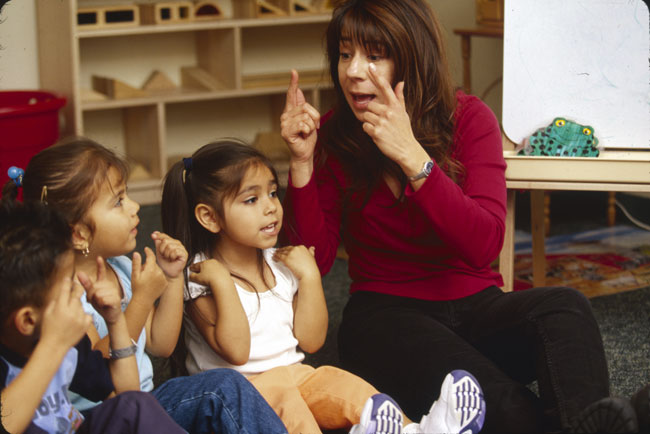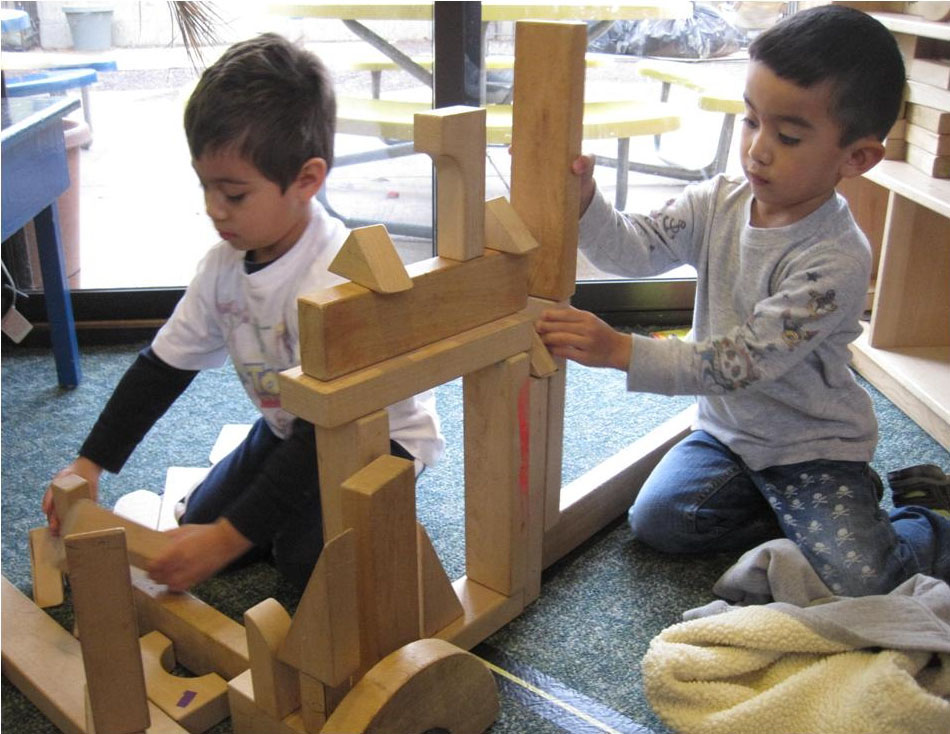Info Link: ABACC Pre-Kindergarten vs. School District Transitional Kindergarten
The Center offers a preschool program for children 36 months to 5 years of age. This program serves 60 children in three classrooms and offers appropriate challenge and interest for active preschool children. The teacher-child ratio for preschool is 1:7.
The preschool is designed to provide an enriched developmental curriculum that will foster children’s dispositions to be curious and involved learners who are active participants in constructing their knowledge of the world. To support the child’s construction of knowledge:
- Teachers support child-initiated engagement and experimentation with a variety of materials based on the child’s interest level and ability.
- Children are encouraged to develop ideas over time, to deepen their understanding of the natural and social world by questioning, exploring, and representing ideas through various creative mediums.
- Indoor and outdoor activities expose the children to art, science, music, dramatic play, and language development on a daily basis.
- Being part of a shared community is actively encouraged. Center teachers emphasize cooperation and create classroom groups that develop concern for each other as they problem solve and work together.
- The curriculum is carried out with the belief that children are learning at all times and that the teacher's role is to facilitate and enrich the learning process.
Arrival
7:30-8:30- Children and parents are greeted by their teacher and children are encouraged to visit a classroom learning center or participate in a table activity. Depending on the time of arrival, children and parents will often use this opportunity to read a book together before their good-byes.
Breakfast
8:30-9:15- Children are provided with a nutritious breakfast prepared fresh in our kitchen. Teachers and children sit family style so that children can express ideas, use language, make plans, and practice good eating habits.
Small Group Inside/Outside Exploration
9:15-10:30- Children have the option to join a larger group of friends on the lower yard or may choose to stay inside to do small group project work with a teacher. Both options give opportunities for fine and gross motor development. On the lower yard, children will co-mingle with other classrooms so that they may develop relationships and practice social skills with new friends.
Circle Time/Planning
10:30-10:45- The morning circle allows the children and teachers an opportunity to come together as a whole group. The whole group experience offers children the opportunity to express ideas, make plans, learn concepts and create a sense of community. Music and stories are utilized as a teaching tool to facilitate language and literacy development and for pure enjoyment! Children are individually dismissed from circle to work on a project of their choosing.
Classroom Project Work
10:45-11:30- Children will work in small groups on a project of their choice. Teachers have also planned activities that will build upon skills and encourage children to explore ideas and concepts through open-ended materials and questioning. Projects can be extended in order to give children an opportunity to add depth and detail to their exploration and research. Through this open-ended balance of teacher/child initiated learning, both teacher and child are researchers. Teachers use observation and documentation of children’s work for both assessment and curriculum development.
Upper Yard outside Exploration
(Optional depending on children’s interest)
11:30-12:00- Children use this time to use our climbing structure, make tunnel systems in the sand or research one of the many insects and critters that have made their habitat the play yard.
Lunch and Nap
12:00-2:30- Our Center is fortunate to have meals cooked fresh daily. Children are separated into small groups and eat family style with a primary teacher. Eating family style in small groups allows children the opportunity to engage in thoughtful conversation and model healthy eating habits. Teachers are active participants in conversation and help to facilitate cooperation and model pro-social behaviors. After lunch, children use the bathroom, wash hands and pick a favorite book to read during rest time. Teachers individually read to each child to insure a calm transition to quiet time.
Teeth Brushing and Snack
2:30-3:30- Children awake to brush their teeth and wash their hands for afternoon snack. Children then self-select a quiet activity while other friends are waking.
Afternoon Circle and Work Time
3:30-4:30- Teachers and children come together to discuss ideas, expand on concepts, read books or play a cooperative group game. Teachers are skilled listeners able to assist children in developing language, cognitive and social skills. This important time of day allows children the opportunity to be thoughtful about their workday and allows teachers the opportunity to assess thought process and to plan curriculum that supports children’s interests and learning.
*Upper yard Option/Departure
4:30-5:30- Children have the option to join a larger group of friends on the upper yard or may choose to stay inside to do small group project work with a teacher. Both options give opportunities to explore the child’s interests. On the upper yard, children will co-mingle with other classrooms so that they may develop relationships and practice social skills with new friends until departure.
*During cold weather the children will come in at 5:00 to work in the Maple Room or on the court yard.

